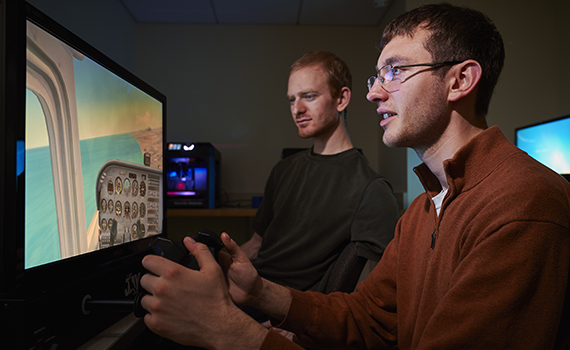
Colin Shipley ’15 (right) takes the controls of the new Redbird Jay flight simulator just purchased by the Aviation Club. Overseeing his flight is the club’s vice president, Aaron Simon ’15. Photo by Andrew Daddio
Navigating the skies of Dubai, from takeoff to landing, is no easy task. But members of Colgate’s Aviation Club have been getting some practice thanks to a new flight simulator that lets users fly any plane in any weather condition in any city in the world.
The new system is kept in room 446 in Case-Geyer Library and is accessible to members of the community upon request to the Aviation Club.
“The flight procedures and checklists are pretty much the same [as with a real plane] prior to takeoff and landing,” said club president Colin Shipley ’15. “We’re able to accustom students to small-aircraft controls and basic flight procedures before they step into an actual cockpit through our Discovery Flights program.”
Colgate’s Aviation Club has existed on and off for about a decade, but Shipley began expanding it in spring 2012 as a Thought Into Action (TIA) project. “With the input of various mentors and student entrepreneurs in the program, I developed a strategy to market the club to the student body and interested alumni,” said Shipley. “Successful projects thus far include the introduction of Soaring Discovery Flights with the Iroquois Soaring Association and the purchase of radio controlled airplanes and helicopters.”
Shipley’s work has paid off. He said, “The Aviation Club’s gift fund was used to purchase the simulator, and one particular alum who is my mentor in TIA provided half of the funds. Another alum and mentor in TIA provided a professional headset for the simulator.” (The noted alumni are Jason Griswold ’97 and Per Sekse ’78, respectively.)
TIA is an integral part of entrepreneurship at Colgate. Since 2009, 101 mentors have helped support 107 ventures involving 171 student entrepreneurs. To learn more, follow these links:
- The Thought Into Action Institute
- Thought Into Action Institute founders
- Thought Into Action Institute mentors
Every semester, approximately 60 students can go up in real planes through the Aviation Club’s Discovery Flights program at Hamilton Municipal airport. From the ground, students can learn how to fly the club’s radio-controlled (RC) blimp and other aircrafts.
“[The simulator] can help familiarize students with the particular type of aircraft they may want to fly in the future, or [help them prepare for] the Discovery Flights,” said Kevin Lynch, Colgate’s chief information officer and the club’s faculty adviser.
“It’s not approved for actual flight training, but it is a useful tool for students,” explained Lynch, who works with small drones and RC aircraft in Colgate’s Information Technology Services department. “Plus, it’s just plain fun,” added Lynch, who himself builds and flies model aircrafts as a hobby.
After Shipley graduates in May, he plans to pursue his private pilot’s license. Meanwhile, Sid Wadhera ’17 and Cat Cronin ’17 will take over the club’s controls. They hope to continue the Discovery Flights program, add hot air balloons as a flying option for club members, and train more students to fly the blimp.
“From the limited flying I’ve done in small aircraft, the [simulator’s] controls and responsiveness to the pilot’s inputs are well done and quite similar to actual flight,” said Shipley.
He added: “Because it’s a desktop simulator, however, there’s only so much of a realistic experience you can have before looking left or right and realizing you’re still in Case library.”
